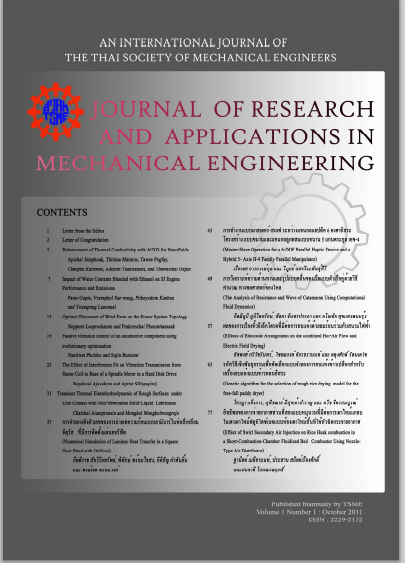Time to seizure comparisons between different plain journal bearings
Main Article Content
Abstract
This paper is a continuation of the research which was presented at last year’s TSME conference. In that paper [1], two new concepts for plain journal bearings were presented. Their design takes advantage of the fact that the coefficient of friction is not just a function of the specific materials sliding together but also a function of time, load and environment. The coefficient of friction will increase with time until a steady state value is reached, where the rate of particle generation matches the rate at which particles are removed. The new designs took advantage of this information by incorporating particle traps and compliant surfaces to reduce friction. Since then an experiment has been designed and built to test both of the new design concepts against a regular plain journal bearing. The experimental data did not produce absolute data on the friction coefficient but it did allow a relative comparison between the different bearings. A time to seizure was produced in every case. The new concepts produced time to seizures ranging from 3 times greater than the regular bearing to over 5 times greater.
Article Details
This work is licensed under a Creative Commons Attribution-NonCommercial-ShareAlike 4.0 International License.
References
[2] Avalonne E., Baumeister T. and Sadegh A. Mark's Standard Handbook for Mechanical Engineers. NY : McGraw-Hill, 2006.
[3] Slocum, A.H. Precision Machine Design. NY : Prentice-Hall, 1992.
[4] Suh, N.P. and Sin, H.C. The genesis of friction. Wear, 1981, Vol. 69, pp. 91-114.
[5] Chowdhury, S.K. and Gosh, P. Adhesion and adhesion friction and the contact between solids. Wear, Vol. 174, pp. 9-19.
[6] Kim, D.E., Cha, K.H. and Sung, L.H. 1, 2002, Design of surface micro-structures for friction control in microsystems applications. CIRP Annals - Manufacturing Technology, Vol. 51, pp. 495-498.
[7] Mosleh, M., Saka, N. and Suh, N.P. 2002, A mechanism of high friction in dry sliding bearings. Wear, Vol. 252, pp. 1-8.
[8] Suh, N.P. Tribophysics. Prentice-Hall, 1986.
[9] Evans, C.J. and Bryan, J.B. 1999, Structured, textured or engineered surfaces. Ann. CIRP, Vol. 48, pp. 541-556.
[10] Wang, A. 2001, A unified theory of wear for ultrahigh molecular weight polyethylene in multi- directional sliding. Wear, Vol. 248, pp. 38-47.



